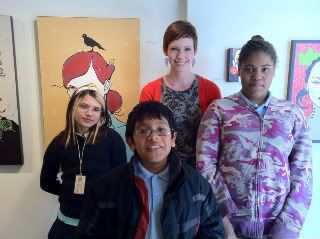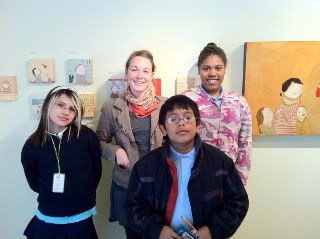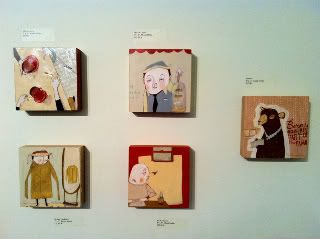Press Club Critiques of "Face to Face"





This dispatch was added by one of our Nonprofit Neighbors. It does not represent the editorial voice of The Rapidian or Community Media Center.





Written by Avelycia O, Tyesha, Gilberto, Alexy, and Hilliel.
Aneka Ingold and Rebecca Green both had their paintings in the Byrneboehm Gallery, and they made an art show called Face To Face. Aneka creates many faces and Rebecca creates cartoonish art with writing on them to make a story. Their paintings were hung like the title of the show—facing each other. Aneka used many rainbow colors in her faces, sometimes where makeup would go on the face. Rebecca likes writing stories to make her paintings easier to understand. When the GAAH Press Club interviewed them, they had a fun experience and learned that mixing colors isn’t as easy as you think.
Press Club: Why did you become an artist?
Aneka: [Art] is rewarding and fun and important to me. I don’t think it’s anything that I’ll ever stop.
PC: Here’s what I think: It’s called “Face to Face, and she did faces and you did faces, and they’re looking at each other.
A: Yeah, that’s a great interpretation.
PC: How come their eyes are so colorful?
A: Well, a lot of it is intuitive. I don’t think too hard about what it means, but I just go with a feeling that I had. It could symbolize that she’s sad, or that she’s thinking hard, and there’s a lot of ways you could see it. But I love color.
PC: They look real...
A: They look realistic, but there’s obviously a lot of color in there that you don’t really see on somebody’s face, unless they were painted like a clown or something.
PC: Which one is your favorite here that you’ve done?
A: I think that my favorite piece personally is the one with the girl with the bird on her head. It was the last piece that I did, and I like the motion in there. It looks like there’s some wind coming through, and I think that the bird on the head makes you think that maybe there’s more of a story that goes with her. Like maybe that was her pet bird, or maybe the bird symbolizes a darker side of her or something.
PC: Is there a website you can go to to see more paintings?
A: To see more of my paintings? Yeah, in fact I have some cards if you each want one.
PC: The question I was thinking when you were pointing to that was that this one looks cuckoo.
A: What do you mean by “cuckoo”? Describe to me what that means.
PC: Weird, because her hair is messy, she has a popping earring, and she has a feather coming out.
A: Those are all things that can maybe give you some hints as to what she’s going through. Maybe she’s going through something rough, and her hair’s messed up. Or maybe the feather came from the bird that’s on the other girl’s head.
PC: So that painting and that painting could be put together?
A: They could.
PC: Is that why they put them together?
A: Yeah, I think they do speak to each other, almost like a diptych.
PC: Because it looks like she’s looking at her, and she’s just getting mad at her.
A: Well, it’s very interesting that you can come up with all of those stories and ideas without me telling you what it means. So, I create an image, and you come up with the story that goes with it.
PC: Where do you get the things to put them on? The equipment?
A: The canvases? Canvas is a fabric stretched on a wood frame, and it has a primer on it called gesso, which is like a white paint. So you have white canvas to start with, and I purchased those at a craft store like Hobby Lobby, Michael’s, Service Reproduction.... There’s a lot of stores in Grand Rapids where you can get those things. You can build your own too, but it takes some training to learn how to do that. But then you have a white surface to start with, and then you get all your paints, different colors, paint pens, and then you can just do whatever comes to mind.
PC: Since that’s your favorite, how come this one is the most famous?
A: Oh, well the gallery owner and the gallery assistant decided what image they wanted to put on the card. So they thought that that one was a good one to put in combination with one of Becca’s pieces to use the colors, so the red and green work together. So I don’t always make the decisions on how the work is marketed. When you work with a gallery, they make decisions too, and they help you decide the best way to present your work.
PC: Do you have more paintings?
A: yes, I have lots and lots of paintings, and I’ve actually worked in different styles than this too. So what you see here is just one body of work. Like the portrait I did of Miss Lori a few years ago was very realistic. It didn’t have any of the colors or marks on the faces. It just looked like real skin.
PC: Were they models for you, or did you just think of it in your head?
A: I mostly work from photographs. So I might take pictures of people I know or work from pictures from magazines or books, just faces that I like or that seem really interesting to me or have some sort of emotion on their face. I start with that, and then use my imagination and make up a lot of stuff too.
PC: What do you do the most, paint or draw?
A: In my whole art career? Probably mostly painting. I did a lot of drawing up until I started college. When I was younger than you guys, I used to draw all the time.
PC: ME TOO! When I was younger than this right now!
A: I’d always have my pencils and paper and would draw all kinds of things. When I started college I started painting and learned how to used different paints: acrylic paints, oil pants, and then learned how to mix colors. You can mix different colors together to make more colors.
PC: I already know how to mix colors. You just get some paint, mix it up, and ta-da!
A: You can teach yourself a lot of things, but if you go to school, your professors can teach you things you might never have thought of. Like Miss Lori is teaching you how to write; you already know how to write! But she might be teaching you how to think about things you never thought about writing about before. But that’s a really good point that you can teach yourself a lot on your own by just experimenting. And I’ve done a lot of that too.
PC: Did you paint the faces for this real quick, or did you take like months and months and months?
A: These paintings all got done probably in the last six months.
PC: That’s a long time.
A: Yeah, but I don’t get to paint every day. I have a family. I have a husband and a two year old son. I also work too, I work at Frederik Meijer Gardens & Sculpture Park.
PC: What if in a hundred years from now, and you died, would this still be here, “Face to Face”?
A: When I die? No, because another show is going to be put up.
PC: Then were will your paintings go?
A: Well, I have my own studio at home, so I’ll take them home. And hopefully I’ll find other places to show my work, other local venues.
[Rebecca arrives]
PC: What do you think about having your paintings in here?
Rebecca: Well, this is my first gallery show, so I was really excited to make paintings for this show. None of the paintings were actually made before this show was planned. So Aneka and I had sat down and kind of thought about what our work was like and how it fit together, and what kind of work we were gonna make. It was kind of hard at first because there’s all this pressure to make something really cool, and make something that people will like and that fits in the space. Sometimes it’s really hard to make work, and then after you’ve kinda let that go and you make what you want, and it turns out good. So I’m excited to have paintings here.
PC: (To Aneka) Is this your first art show?
A: This is not, but it’s my first big gallery show.
R: Yeah, I’ve had smaller shows, like I had one in Sparrows, so did [Aneka].
PC: I can tell by your pants.
R: Yes! And I was on the floor!
PC: How do you make your paintings good?
PC: Use your imagination!
R: Exactly.
A: We talked earlier about how you can use your imagination and you can make stuff up on your own, but going to school, which Rebecca and I have both done for art, can teach you how to do certain things better.
PC: How come on this one it has writing on the bottom?
R: Most of them do have writing on them. That’s a big thing with my work, is that I like to put writing in there because I like stories, and I like writing stories.
PC: When I draw I always use my imagination.
R: That’s awesome!
PC: Some times when I’m bored I just do anything, and then suddenly, I drew something!
R: I think going to school and learning how to draw real life, and still life, and people, and buildings and stuff, and you learn how to make a picture or a drawing that looks like real life. And once you learn how to do that, then you can use your imagination and you can use those things you learned in the drawings that come out of your mind and it kind of makes those look real.
A: The really cool thing about art work is that you can’t really mess up because no matter what you do, it’s art. It can be interpreted in many different ways. So when you see something stands out to you, someone else might not.
PC: Last time when I did scribbles, it kind of looks like a cat when they get scared.
PC: More questions! Why did you became an artist?
R: I think I’ve been doing it for a long long time. Even in elementary school and high school.
PC: What about middle school?
R: In middle school too. All the way through. And I think when I got into high school I realized that I wanted to do it for real. And then it was kind of scary because it’s sometimes hard to make a living, like make money doing art. So that’s a scary thing. But I think when I was in high school I decided for sure [to be an artist], and then I went to school at Kendall College.
PC: Do you sell your paintings?
R: Yeah, I do sell a lot of work, and you know I make a lot of smaller pieces and those sell a lot easier.
PC: So you don’t make the big ones?
R: I do make some big ones, but mostly smaller ones because those are easier for people to buy, and those are fun to paint for me.
PC: How did you get your paintings in here?
R: I was doing a show at another place where they have all these artists come in and paint live, like they do a painting right on the spot.
PC: Aww, that’s cool! I wish I was there!
R: Yeah, and then they auction all of the paintings off. So it’s a big fundraiser, and there’s probably like 60 artists. They’ve all got their easels, and Aneka does this too, but they paint right there on the spot, and you can watch them paint and then they sell all of the paintings. [The gallery owner] Kevin saw my painting at that show, and talked to his assistant here about having a show, and she thought that Aneka would be a great fit. And they decided to show our work because it goes together.
PC: Can we go look at your paintings now?
A: Sure! Yeah, go take another look!
The Rapidian, a program of the 501(c)3 nonprofit Community Media Center, relies on the community’s support to help cover the cost of training reporters and publishing content.
We need your help.
If each of our readers and content creators who values this community platform help support its creation and maintenance, The Rapidian can continue to educate and facilitate a conversation around issues for years to come.
Please support The Rapidian and make a contribution today.